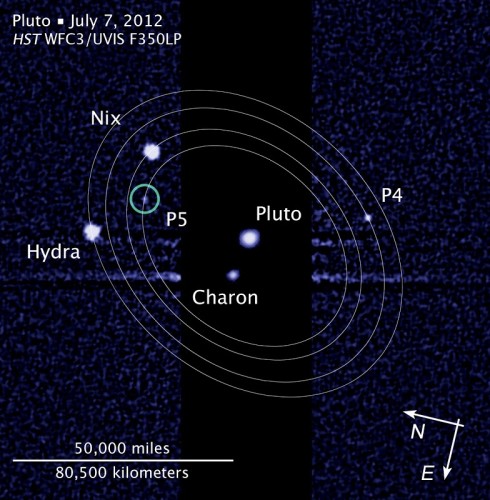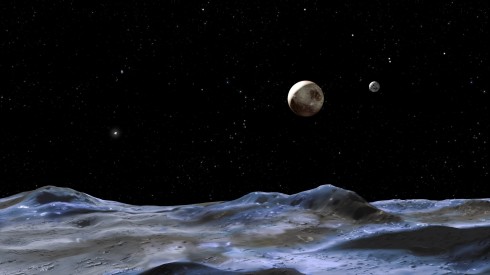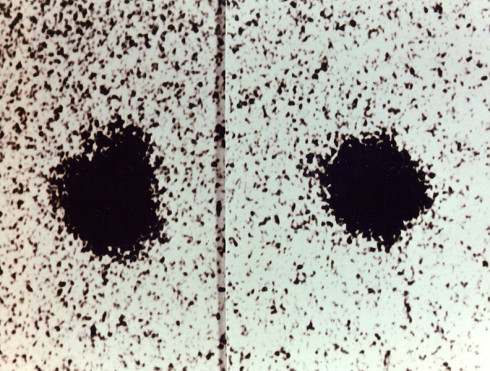Pluto’s new moons named: Spock still homeless


The dwarf planet, Pluto, can still generate plenty of public interest – if the naming of its two recently discovered moons is anything to go by. After their discovery, the leader of the research team, Mark Showalter, called for a public vote to suggest names for the two objects. The on-line contest, aptly named ‘Pluto Rocks!‘, concluded with Vulcan as the outright favorite, after a William Shatner led push by Star Trek fans. The names Cerberus and Styx ranking second and third respectively. The International Astronomical Union (IAU) has announced that the names Kerberos and Styx have officially been recognised for these fourth and fifth moons of Pluto. A decision that is probably correct, even if it proves not to be the most popular.
The moons of Pluto
The new moons were discovered in 2011 and 2012, during observations of the Pluto system made with the NASA/ESA Hubble Space Telescope. Their discovery increasing the number of known Pluto moons to five. Kerberos lies between the orbits of Nix and Hydra, two bigger moons discovered by Hubble in 2005, and Styx lies between Charon, the innermost and biggest moon, and Nix. Both have circular orbits assumed to be in the plane of the other satellites in the system. Kerberos has an estimated diameter of 13 to 34 kilometres, and Styx is thought to be irregular in shape and is 10 to 25 kilometres across.

The recent discoveries of the two small moons orbiting Pluto raise interesting new questions about how the dwarf planet formed. We now know that a total of four outer moons circle around a central “double-planet” comprising Pluto and its large, nearby moon Charon.
No home for Spock
The International Astronomical Union (IAU) is the arbiter of the naming process of celestial bodies, and is advised and supported by astronomers active in different fields. On discovery, astronomical objects receive unambiguous and official catalogue designations. When common names are assigned, the IAU rules ensure that the names work across different languages and cultures in order to support collaborative worldwide research and avoid confusion.
To be consistent with the names of the other Pluto satellites, the names had to be picked from classical European mythology, in particular with reference to the underworld — the realm where the souls of the deceased go in the afterlife. Showalter submitted Vulcan and Cerberus to the IAU where the Working Group for Planetary System Nomenclature (WGPSN) and the Committee on Small Body Nomenclature (WGSBN) discussed the names for approval.
After a final deliberation, the IAU Working Group and Committee agreed to change Cerberus to Kerberos — the Greek spelling of the word, to avoid confusion with an asteroid called 1865 Cerberus. According to mythology, Cerberus was a many-headed dog that guarded the entrance to the underworld. In keeping with the underworld theme the third most popular name was chosen — Styx, the name of the goddess who ruled over the underworld river, also called the Styx.
The IAU decided against the name Vulcan for a number of reasons: Vulcan had already been used for a hypothetical planet between Mercury and the Sun (although this planet was found not to exist), the term “vulcanoid” remains attached to any asteroid existing inside the orbit of Mercury, and finally Vulcan does not fit into the underworld mythological scheme. The Romans identified Vulcan with the Greek smith-god Hephaestus, and he became associated like his Greek counterpart with the constructive use of fire in metalworking.
In a press release the IAU has stated that it:
wholeheartedly welcomes the public’s interest in recent discoveries, and continues to stress the importance of having a unified naming procedure following certain rules, such as involving the IAU as early as possible, and making the process open and free to all. Read more about the naming of astronomical objects here. The process of possibly giving public names to exoplanets (see iau1301), and more generally to yet-to-be discovered Solar System planets and to planetary satellites, is currently under review by the new IAU Executive Committee Task Group Public Naming of Planets and Planetary Satellites.
It all began with Galileo
Naming moons is not a new controversy. No sooner had telescopes been developed – improving on viewing the heavens by eye – and naming rights were contested. Galileo Galilei discovered the four largest moons of Jupiter sometime between 1609 and 1610. Galileo initially named his discovery the Cosmica Sidera (“Cosimo’s stars”) in the hope of gaining patronage from a former student of his the Grand Duke Cosimo II of Tuscany. He changed this to the “Medician Stars”, which would honor all four brothers in the Medici clan, in his 1610 book Sidereus Nuncius (The Starry Messenger). Their present names (lovers of the god Zeus (the Greek equivalent of Jupiter)) were suggested by Johannes Kepler, to Simon Marius, who had discovered the moons independently around the same time as Galileo. Marius published the names: Io, Europa, Ganymede and Callisto, in his Mundus Jovialis, in 1614.

Despite the firm hand of the IAU, naming even in the present day is still an art as much as a science. Charon was discovered in 1978 when astronomer James Christy noticed images of Pluto were strangely elongated. The direction of elongation cycled back and forth over 6.39 days – Pluto’s rotation period. Searching through their archives of Pluto images taken years before, Christy found more cases where Pluto appeared elongated. Additional images confirmed he had discovered the first known moon of Pluto. Christy proposed the name Charon after the mythological ferryman who carried souls across the river Acheron, one of the five mythical rivers that surrounded Pluto’s underworld. Apart from the mythological connection for this name, Christy chose it because the first four letters also matched the name of his wife, Charlene.
New Horizons, Pluto and the Kuiper Belt
Pluto’s origin and identity has long puzzled astronomers. Orbiting at a distance of between 4.4–7.4 billion kilometres from the Sun it has proved difficult to investigate. Pluto’s true place in the Solar System began to reveal itself only in 1992, when astronomers began to find small icy objects beyond Neptune that were similar to Pluto not only in orbit but also in size and composition. Astronomers now believe Pluto to be the largest member of the Kuiper belt, a somewhat stable ring of objects located between 30 and 50 AU from the Sun. Though Pluto is the largest of the Kuiper belt objects discovered so far, Neptune’s moon Triton, which is slightly larger than Pluto, is similar to it both geologically and atmospherically, and is believed to be a captured Kuiper belt object.
The excitement for Pluto and its moons will be heightened in 2015 when NASA’s New Horizons spacecraft makes a flyby and then continues on to study the Kuiper belt objects in 2016-2020. It has already been suggested by Showalter that some of the names from the Pluto Rocks list, as well as some from Star Trek, may well names of craters and mountains, revealed on Pluto by New Horizons – this story is far from over.
Orrman-Rossiter K (2013-07-05 00:09:08). Pluto's new moons named: Spock still homeless. Australian Science. Retrieved: Jul 27, 2024, from http://ozscience.com/space/plutos-new-moons-named-spock-still-homeless/
 Follow
Follow
Now Showalter has spotted a new moon around Neptune. http://www.wired.com/wiredscience/2013/07/neptunes-new-moon/